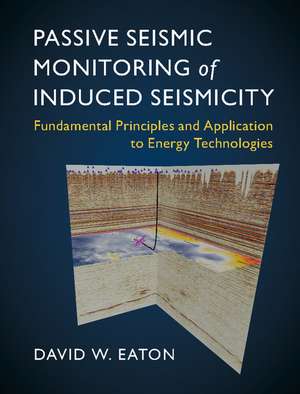Passive Seismic Monitoring of Induced Seismicity: Fundamental Principles and Application to Energy Technologies
Autor David W. Eatonen Limba Engleză Hardback – 25 apr 2018
Preț: 634.23 lei
Preț vechi: 823.68 lei
-23% Nou
Puncte Express: 951
Preț estimativ în valută:
121.36€ • 129.78$ • 101.19£
121.36€ • 129.78$ • 101.19£
Carte tipărită la comandă
Livrare economică 14-21 aprilie
Preluare comenzi: 021 569.72.76
Specificații
ISBN-13: 9781107145252
ISBN-10: 1107145252
Pagini: 360
Dimensiuni: 192 x 254 x 22 mm
Greutate: 1 kg
Editura: Cambridge University Press
Colecția Cambridge University Press
Locul publicării:New York, United States
ISBN-10: 1107145252
Pagini: 360
Dimensiuni: 192 x 254 x 22 mm
Greutate: 1 kg
Editura: Cambridge University Press
Colecția Cambridge University Press
Locul publicării:New York, United States
Cuprins
Preface; List of symbols; Part I. Fundamentals of Passive Seismic Monitoring: 1. Constitutive relations and elastic deformation; 2. Failure criteria and anelastic deformation; 3. Seismic waves and sources; 4. Stress measurement and hydraulic fracturing; Part II. Applications of Passive Seismic Monitoring: 5. Passive-seismic data acquisition; 6. Downhole microseismic processing; 7. Surface and shallow-array microseismic processing; 8. Microseismic interpretation; 9. Induced seismicity; Appendix A. Glossary; Appendix B. Signal-processing essentials; Appendix C. Data formats; References; Index.
Recenzii
'It is now well established that human activities in the subsurface create induced seismicity. While large events can be extremely problematic from both a seismic hazard and operational safety perspective, smaller induced events, known as microseismic events, can tell us a great deal about changes in the subsurface. Eaton provides a clear and comprehensive description of such seismicity, starting from first principles and then progressively taking the reader through to real examples and case studies. A focus is on seismicity associated with oil and gas exploitation, but the book will also appeal to scientists interested in seismicity in a range of other settings (e.g., geothermal, mining, etc.). Eaton has crafted an excellent seismology text for students and earthquake seismologists in general.' Michael Kendall, University of Bristol
'Passive Seismic Monitoring of Induced Seismicity is a comprehensive textbook covering basic theoretical concepts of seismic and ancillary topics through to practical implementation in industrial settings. The book is an essential reference text on this topical technology.' Shawn Maxwell, Itasca Microseismic and Geomechanical Evaluation
'This comprehensive text is a much-needed and timely overview of topics related to seismic monitoring of induced earthquakes. It not only provides a thorough treatment of how microseismic monitoring is done and the data are analyzed, it provides a valuable overview of how and why injection-induced seismicity occurs.' Mark Zoback, Stanford University, California
'Passive Seismic Monitoring of Induced Seismicity is a comprehensive textbook covering basic theoretical concepts of seismic and ancillary topics through to practical implementation in industrial settings. The book is an essential reference text on this topical technology.' Shawn Maxwell, Itasca Microseismic and Geomechanical Evaluation
'This comprehensive text is a much-needed and timely overview of topics related to seismic monitoring of induced earthquakes. It not only provides a thorough treatment of how microseismic monitoring is done and the data are analyzed, it provides a valuable overview of how and why injection-induced seismicity occurs.' Mark Zoback, Stanford University, California
Notă biografică
Descriere
An introduction to the principles and applications of passive seismic monitoring, providing an accessible overview of current research and technology.
